 |
|
|
|
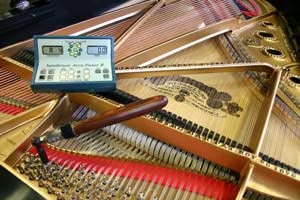
Some of the most commonly asked questions about our services relates to piano tuning and how much it costs. The simple answer to the question is that all pianos differ, and the rates will vary. Piano tuning is exactly what it implies… the tuning pins will be moved (with a tuning hammer), and set to the appropriate tension in order to produce the correct sound.
The way a piano plays is NOT affected by normal piano tuning. In fact, the action (or mechanics) of the piano are not regulated or removed during the course of normal piano tuning. If the action of the piano has a problem before the piano is tuned, it will have the same problem after tuning unless repairs or regulation are performed to correct it. Any problems a piano may have will be identified, and the customer will be informed of any issues that need to be addressed, either before the tuning begins, or within the course of the tuning as they arise.
- On well-maintained pianos that have been tuned regularly (every 6 months) and do not require repair or regulation, the typical service call tuning charge is $125-$150 (within our normal service area).
- Pianos that have not been tuned for at least year or two, or have undergone a drastic climatic change, typically require what is called a "pitch raise" (basically a double tuning), and the rate will be between $150 and $185 (within our normal service area).
- Pianos that have not been tuned "for years", or that do not play properly, should first be evaluated to insure that the instrument is capable of maintaining a proper tuning, and it is worth putting the money into the piano to bring it back to shape (see below).
Back to top of page...
|
|
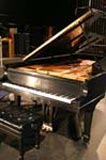
This is a fair and complex question. For the most part, we can perform
restorations to many differing levels of budget and customer need… within
reason.
For example, we have seen MANY older pianos come through our studio
where a basic interior cleaning, action regulation, tuning and voicing
is all that is needed to restore the piano to a wonderful playing and
sounding condition. These services can run anywhere between $750 and
$2500 depending on the extent of the work.
In other cases such as basic interior rebuilding which includes, restringing,
damper work, hammer replacement, regulation, tuning and voicing, the
prices can range between $2500 and $5000. This type of rebuilding is
commonly used on lesser quality pianos, to put them into satisfactory
condition, without going way beyond the value of the piano when it is
complete.
The typical interior restorations we see for Vintage Steinway and Sons
Pianos, from say 1900 to the more current production
models, typically range in the $8000 to $12,000. These
pianos will generally need and receive new pinblocks,
soundboard repairs, bridge repinning, new Renner action parts,
capo and agraffe work, keytop replacement or Ivory repair, key
repairs, damper action replacements, and thorough regulation
and voicing.
A top-end, full-blown interior restoration of a very old (pre-1900),
or especially worn-out Steinway Piano can reach upwards
of $20,000 to $30,000. In addition to the typical
Steinway Piano restoration above, these pianos will include:
new soundboards with new bridge caps, new keyset duplication,
keyframe rebuilding, rim reconstruction and repair, complete
new damper systems, and more extensive voicing and regulation
work.
Still, this restoration, although expensive, is by far a better bargain
than the purchase of a new hand-made, high-end quality
piano. Most start at $35,000 for the smallest of baby
grands and reach upwards of $125,000 for concert grands and art-case
style cabinetry!
Back to top of page...
|
|
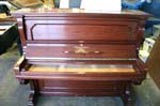
Piano refinishing costs will vary depending on the size, color, texture and quality of the finish being applied. From the smallest upright piano with the most basic finish applied, prices will start at $1500 and go up to about $3500. Typical mid-sized parlor grands, in a basic ebony-satin finish, with hardware plating and case repairs, generally cost between $3500 and $5000. As the pianos get bigger, or the finishes become more exotic (such as high-gloss, or ornate carvings throughout), costs are generally between $5000 and $9000. Every piano is different and must be evaluated individually in order to accurately estimate a refinishing cost.
Back to top of page...
|
|
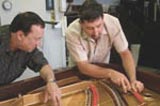
We are often asked to do a piano estimate or evaluation for repairs.
This is one of the most important steps an owner can
take in order to insure that they are spending their
money wisely on an instrument, and whether or not a restoration
should even be performed.
In the course of an evaluation,
the piano is looked over closely for its current condition,
and its potential for restoration. Components given
great attention include: the soundboard, plate, action and
damper system, pinblock and belly, pedals and trapwork,
and finally, the finish and veneers of the instrument.
Based on these examinations, a rough estimate of the instrument's current
retail and wholesale value are determined, as well as the costs for
restoring the instrument to the highest level of the customer's expectations.
A formal proposal is then compiled and sent via mail to the customer.
Faxing and emailing are also provided as a service
to those that need the evaluation quickly. Typically the rates for an
evaluation are approximately $100 to $200 (within our normal service
area).
Back to top of page...
|
|
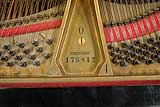
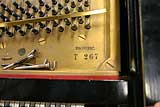
The images above can be enlarged by clicking on them
These pictures illustrate where to look for the Serial and Model Number
(above left), and Part Number (above right) for your
Steinway and Sons Grand Piano. These numbers can be easily
identified on the plate, underneath the music rack (which
simply slides out of the piano). If the numbers are not
on your Steinway, it has more than likely been refinished
and carelessly left off the instrument by the refinisher.
Not to worry! Part Numbers and Serial Numbers are in
multiple places on Steinway instruments...it will just
take a little more effort to find them! The word "Ebonized" indicates
that the piano was destined to have a black finish.
Back to top of page...
|
|
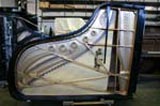
This is by far our most commonly asked question. After
all, restoring a high-quality grand piano is an expensive
endeavor indeed. But with the cost of new high-end, hand-built pianos
that start at $35,000 (for the smallest baby grands),
and go all the way up beyond $125,000 (for concert grands
and art-case style cabinetry), the opportunity to restore
an older, Vintage Steinway and Sons, Mason and Hamlin,
Bösendorfer, Baldwin, etc., is by far a better bargain!
In fact, in many cases, the results of restoring a vintage
hand-made piano exceed the standards of some brand new
pianos.
If your piano does not have name recognition on the fallboard, then
a thorough evaluation is needed in order to insure that
the money you spend, does not far outweigh the piano's
value, and that the restoration will produce a piano
that will be playable and enjoyable for years to come.
The fact of the matter exists that there are MANY good
quality, reasonably priced, middle-of-the-road, brand
new pianos out there that many people could (and should)
buy. This leaves the resale value of many older, lesser-known
pianos well below what it costs to do a proper restoration.
It is up to the customer at that point, to decide whether
or not restoring their older piano is worth it to them.
At least you will be armed with the facts in order to
make the decision that is right for you.
Back to top of page...
|
|

The vast majority of our piano restorations that do not include refinishing
of the instrument take approximately 8-12 weeks to complete.
Of course, every piano, and every restoration are different.
If a piano is to be refinished, have a new soundboard
and new keyset installed, and restored to the highest
degree, the process could take as long as 9 months to
finish.
Back to top of page...
|
|
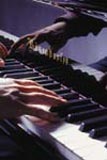
This is a very commonly asked question. The best answer is that there
is no "one" piano that is the best. There are numerous
high quality, hand-made grand pianos that can be considered
extraordinary. Following is a short list of just a handful
of the many piano makers we consider exceptional.
Steinway and Sons is the most well known instrument ever produced,
and has a proven track record of building concert level
instruments. With this quality, comes a reputation and
respect that makes Steinway the benchmark for all others
to follow. Founded in 1856, Theodore Steinway took the art of piano
construction into the modern era, establishing patents, that to this
day, other manufacturers have adopted and used as the standard for piano
building.
Introduced at Winter NAMM 2005, is the Model A Grand Piano
in the 6' 2" configuration.
Steinway originally introduced the model A (6'1") in 1878, and
later produced 2 larger versions of the same model, culminating
in the (6'4"). The newest
piano is based on the second largest size. Introduced
at Winter NAMM 2006, is the rebirth of the Steinway Model
O Grand Piano in the 6' 10 and 3/4" size.
These are American Steinway's first new grand piano introductions
in many, many decades!
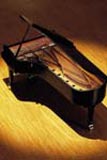
Bösendorfer, a uniquely designed and built Austrian piano,
has an impeccable reputation for its power and tone, and for the extraordinary
workmanship that goes into making each instrument. These
pianos are built in the "old-world" tradition
of hand craftsmanship even to this day.
Mason and Hamlin, built in Boston, MA, was established in the 1800's.
They were Steinway and Sons most major competition, not
only in piano building, but on the concert stages of
America for many, many decades. Their patented Tension Resonator System
utilized steel bars that kept the frame of the piano pulled together
and under tension.
Newly introduced at winter NAMM 2005, is the Mason and Hamlin Model
CC94 (9'4") Concert
Grand with 2 Tension Resonators. Only 15 Vintage CC Concert
Grands in the 9'4" configuration
were ever produced. The newest version is based on
that design. Impeccable workmanship and excellent scale
designs make Mason and Hamlin's sought after by many
pianists.
Yamaha, Japan's oldest and most prolific piano maker, is one of the
best dollar-to-value ratio pianos ever produced. Incorporating
all of the most sought after technological break-throughs
in piano building, these pianos are truly spectacular
in fit and finish. Yamaha has also taken the player piano
industry by storm. The Yamaha Disklavier Player Piano System is by far
the best reproducing system on the market, and accounts for a large
portion of their new piano sales. The Disklavier System is only available
as a factory installed option on their new pianos, and is not available
to install on any other pianos.
Back to top of page...
|
|
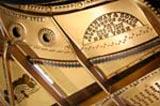
We are firm believers in the installation of new soundboards into high
quality instruments such as Steinway and Sons Pianos.
The nay-sayers that believe one must keep the original
soundboard of an instrument at all costs, are deluded
in their thinking and are not facing the real world facts
about piano soundboards.
To expect a piano soundboard
that is 75-125 years old to retain its original crown
and cellular structure in the spruce, is ludicrous.
The fact of the matter exists that soundboards have a
life span. Pianos are subjected to 12-15 tons of pressure
in the strung and concert pitch condition. This pressure
is spread throughout the entire body of the instrument,
and there is an enormous force at work to push and
pull the inner and outer rims, belly and soundboard apart.
The downward pressure that this force exerts on the
soundboard (also known as the bearing), could be as much
as 200 to 300 pounds combined.
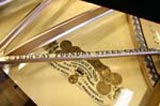
To expect the soundboard to
withstand this force for 75+ years, and retain its
original crown, tone and sustain, simply will not happen. The effects
of this force are observed even more readily on the
larger sizes of pianos, from 6 feet and up. A 9 foot
Vintage Steinway soundboard panel, when removed, is usually
flat as a table, and, more often than not, reversed
in crown. If the new soundboard that is to be installed, is duplicated
to the exact standards of the original soundboard
being removed, then the piano will sound as it did when it was new.
We are not here to reinvent the wheel, or second-guess Steinway's piano
building processes. When a new board is installed,
it is as the original was.
All this being said, we also believe that considering the expenditure
involved in the installation of a new soundboard, it
is definitely not for everyone. If the budget for the
restoration of the piano cannot absorb the cost of a
new Board, then a thorough shimming, gluing and preparation of the old
board is a must. Replacement is generally reserved for those that expect
the ultimate in tone reproduction from their Vintage Steinway.
Back to top of page...
|
|
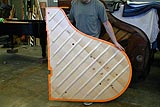
One of the most disturbing trends we are now seeing in the cheap wholesale piano restoration business is the installation of low-grade, generic soundboards into high quality pianos such as Vintage Steinways. These boards are made from a "standard" generic pattern, meaning they are NOT duplicated to the specifications of the original soundboard that is being removed from the instrument. Board thinning (or diaphragmization), rib material, bridge notching, and placement are all being set to this standard in order to speed up production and cut down costs. These soundboards are very inexpensive, but have no value in high end piano restoration. We have even seen these cheap soundboards available for purchase on eBay!
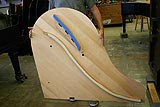
When we replace a soundboard in a Vintage Steinway, great care is taken to reproduce the diaphragmization, rib position and material, and bridge locations to exactly match the dimensions of the original board removed from the piano. In our opinion, this is the ONLY way to accurately ensure that the piano will sound as it did when it was new, and faithfully reproduce the tone that piano makers such as Steinway and Sons originally intended for the era of the piano being restored.
Back to top of page...
|
|
If the new soundboard is duplicated to the exact characteristics of the original board that is removed, then absolutely not!
Back to top of page...
|
|
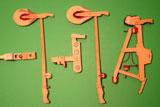
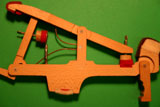
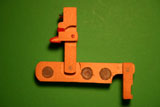
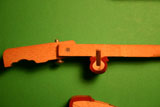
In the 1960's, Steinway developed Teflon action components which were used from that time until the very early 1980's. These components feature Teflon circles around the centerpins of all the moving parts of the action components which include the hammershanks, wippens, damper underlevers, and parts of the Sostenuto system and lyre. There were 2 sizes of Teflon circles: small and large. Teflon components can be repinned with special straight reamers and pre-cut pins that are supplied in repair kits still available from Steinway New York.
In theory, Teflon will not wear out like a normal felt bushing and can be reamed to an exact standard of friction. This sounds like the perfect material to use on a piano component that requires consistency, right? In practice, the Teflon circle is subject to the changing characteristics of the wood surrounding the material, and therefore pinning becomes inconsistent.
In humid weather, the wood swells around the Teflon causing the bushing to tighten up and increase friction on the centerpin... The result is increased touch weight and sluggish parts. In dry weather, the wood shrinks around the Teflon, causing a loose centerpin with little to no friction for the opposite problem. In the worst case situation, the action will be extremely noisy and click and clack as if playing a typewriter!
Repinning and reaming Teflon components is a lesson in futility. It is not a cure for action problems in an affected Steinway Piano. The only sure cure is replacement of the components with quality Renner dimensionally correct action parts.
Back to top of page...
|
|
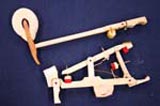
Our replacement parts of choice include Renner action parts, and Renner
hammers. The reasons we choose this maker is a track-record
of proven quality (since 1882), and exact geometry reproduction
for Vintage Steinway and Sons Pianos. Renner produces
over 4 different shank and flange configurations, and
3 different wippen configurations. These choices provide
the exact fitment needed to make a Vintage Steinway perform
and feel perfect.
The quality of the Renner hardwood (Hornbeam) used on the parts exceeds the specifications of maple, and the center-pinning is always firm and sluggish-free. The Premium Blue Renner hammers produced are offered in many different sizes and weights that can exactly duplicate what was originally intended for use in the Vintage Steinway action. The layering of the felt fibers in the Renner piano hammer also duplicates Steinway's original (long since abandoned) process for hammer making. Renner action parts are currently used by the finest piano makers in the world which include: German Steinway and Sons, Mason and Hamlin, Bösendorfer, Schimmel, Fazioli, Bluthner, Grotrian-Steinweg, and many others. Nothing we have used in the past comes close to the quality of Renner parts.
On special request, we will use factory original parts from American Steinway, but only if they will work and fit properly on the era of piano being restored. In general, new Steinway original parts will require extensive modifications to the action stack, keyset, and keyframe in order to correct geometry and parts convergence issues.
Back to top of page...
|
|
Early use of plastic in piano actions from the 1930's and 1940's resulted in horrible degradation of the materials, to a point where they simply disintegrated when handled. This was caused by a basic lack of knowledge about the characteristics of the materials at that point in history. It rendered many pianos, mostly spinets and small uprights, completely useless, and not worth repairing. This has also resulted in giving plastics and composites a "bad-rep" in the piano industry.
In December, 2008, the Wessell, Nickel and Gross company introduced their new line of replacement composite action components for pianos such as Steinway and Sons, Mason and Hamlin, Bösendorfer, and many others. These types of revolutionary components have been used for many years by manufacturers such as Yamaha and Kawai, with Kawai leading the industry with their development of the Millennium III ABS-Carbon Action. These new composite materials have undergone years of testing and evaluation, and the advantages over wood components are significant.
Composite components have greater strength, uniformity and accuracy over their wooden counterparts. Wood is hygroscopic and will change with the different levels of humidity that naturally occur in their environment. Over many years, the effects of these changes show up as warping and distortion of the wooden components. Composites are completely free of these effects.
Wood is organic, so its structure varies greatly from piece to piece, making machining of the components extremely difficult, and very hard to duplicate to the same standard each time. Because of the injection molding process, composites are duplicated to a precise standard with each piece produced.
The following pictures illustrate the radical new "look" of composite action parts (top row), and compared to traditional Genuine Renner Replacement Parts (bottom row):
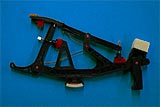
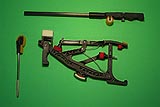
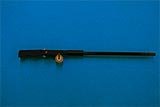
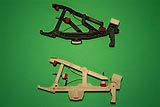
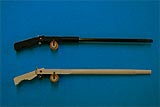
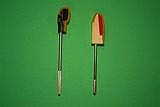
Click on the images above to enlarge.
Despite the improvements and proven benefits that composites offer over wood, many traditionalists and piano industry leaders denounce the use of these high-tech components. It is much easier to dismiss something new as a gimmick or unproven, rather than to give it a fair chance and evaluate the facts. This makes the road to acceptance very difficult for any company striving to develop new and improved products for the piano market.
WNG has produced an exciting new line of piano parts that promise to deliver performance that will far exceed the specifications of wood. Before we commit to offer these components in our restorations, we will be evaluating and studying these composites in our own test pianos to see if they truly live up to the standard that our discerning clients have to come to expect. Updates will follow as the results of our studies become apparent.
To read more about this company and their composite action components, please visit the Wessell, Nickel and Gross web site.
Back to top of page...
|
|
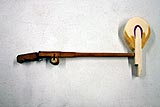
The most common problem associated with a heavy action is incorrect
parts selection. Most rebuilt pianos we encounter have
the wrong parts installed on them. Too heavy a hammer
will cause the piano to play like a truck. Wrong part
dimensions destroy the geometry of the action, resulting in a heavy
touch-weight. Believe it or not, we even see piano actions come directly
from the factory with incorrect rail configurations making the parts
on the action line up incorrectly! Parts selection, geometry analysis,
and fit and finish of all the components, will correct the "heavy
playing piano" syndrome.
Back to top of page...
|
|
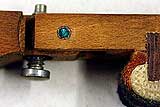
The most common cause of sticky keys on Vintage Steinway Pianos is
Verdigris on the centerpinning, or pivot points of the
action components. For many years, Steinway dipped their
action parts in a paraffin oil to act as a preservative
for the wood. The result is a chemical reaction with the center pins
and felts on the parts, causing Verdigris corrosion (see picture). There
is no permanent cure for Verdigris. The parts must be replaced to correct
this situation.
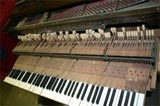
To the right is an extreme example of a 1920's Vintage Steinway and Sons Grand Piano rendered completely unplayable by Verdigris. Almost all the hammers are stuck in the air by Verdigris seizing the centerpin.
Back to top of page...
|
|
Pianos are made of wood, metal, felt and leathers. These parts will
all change with age. Leather hardens, felt wears out,
wood deteriorates, and metal fatigues. As the piano gets
older, the combination of all these parts changing results
in a piano that will have playability issues (no more
controllable pianissimos or fortissimos). There will
be noise in the action, noise in the pedals, strings
breaking, and a general sloppy sound and play.
We find
that many times, a pianist simply becomes used to the
piano playing at a substandard level, and they simply
adapt in order to make it work. This results in very
poor performance. When this same person plays a recently
restored instrument, not only does their performance
improve, but the joy of playing the piano is restored!
Back to top of page...
|
|
The simple answer is that since about 1990 on, we have been living
in the golden era of piano rebuilding. As rebuilders,
we have the best resources ever to obtain and use the
highest quality piano parts ever produced for the piano
industry. This was not true in the 1960's through 1980's.
Many times, there was only one choice in a piano component,
and it was usually wrong. Even with the best of intentions,
piano rebuilders during that time period would have to
compromise, and make things work (whether they fit or
not). This leaves many consumers with the decision to
rebuild their piano (again), with proper materials and
workmanship. The advantages are now far better.
Back to top of page...
|
|
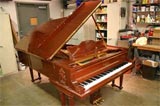
Buying a used Vintage Steinway can be one of the most stressful experiences a consumer can go through. The used piano business is not unlike the used car business. Many sellers, whether intentionally or not, misrepresent the facts about used pianos. The old saying, "You get what you pay for," usually rings true when buying a used rebuilt piano. Attention to detail is not something that can be done to a piano for a low price. There are MANY more poorly restored Steinway's in the used marketplace than good ones. In general, the cheaper the piano, the lower the quality of the instrument. Great care and research should be used when buying a vintage, rebuilt Steinway.
Back to top of page...
|
|
The first step is to do your homework and visit rebuilder's businesses. Find someone that you are comfortable speaking with, and who does not "sugar coat" their advice about piano restoration. This is the best type of individual to hire and evaluate a prospective piano to purchase. There are no shortcuts to restoring a piano properly, and a skilled rebuilder will identify deficiencies in a piano accurately and fairly. We believe the most honest advice comes from rebuilders that do not have a stake in buying or selling pianos. There is no conflict of interest when the restoration specialist concentrates ONLY on the piano that YOU want to have restored.
Back to top of page...
|
|
We do not buy and sell pianos. Our business is piano restoration, rebuilding, and service only, with an emphasis on Vintage Steinway and Sons. We occasionally inherit pianos that have been abandoned by clients for one reason or another. These pianos are finished as intended, and are available for purchase upon completion. Please call for any current projects we may have underway.
Back to top of page...
|
|
One of the most daunting tasks for a consumer considering piano restoration is their choice of a piano restoration specialist. Here are a few tips to help guide you in the right direction:
-
PLAY the pianos that have been finished by the restoration company. Are there a lot of excuses that come up during the "test drive" of the piano? Are they all not quite finished, or will the actions get easier to play the more you use it? Do they need more tuning or more voicing to sound good? Lots of imaginative excuses should be a red warning flag to anyone considering a restoration with this type of company!
A big warehouse with lots of fancy machines, tools and jigs means absolutely NOTHING if the skills needed to utilize those devices are not there. The proper tone and touch of a piano are only learned through years of study, and not simply by calling oneself a Piano Rebuilder. A good rebuilder should spend YEARS tuning and tone regulating new and used high end instruments in order to hone his skills in determining what a piano should truly sound and play like. In order to restore a piano properly, one should know what the ultimate goal of tone and touch should be. Ask for reputable references and proof of ones history of piano service. Most of the time, a good rebuilder's name will come up multiple times and from many different, and well respected tuners, technicians, reputable dealers, and pianists.
-
Is the emphasis of the company more on selling pianos? As stated above, we believe the most honest advice about restoring pianos comes from those that have no interest in the buying and selling of pianos. If there are "hundreds of used pianos available," or, "We restore hundreds of pianos per year," then let the buyer beware.
-
Are you comfortable with a large wholesale operation, or is a smaller, more personal environment appealing to you? If your main objective is to simply have a pretty looking Steinway and Sons Piano sitting in your living room, regardless of touch or tone, then a large scale wholesale restoration outfit might suit your needs just fine. But, the low price, and quick completion time for the restoration will be equal to the low quality of the final result. There is no possible way for high level, concert-ready piano restoration to be performed quickly, or for low price. There is so much minutia and skill required to bring pianos that are 50 to 150 years old to an as new condition, that low prices and poorly paid laborers simply cannot provide this type of work. You as the consumer must make the best decision that suits your needs.
-
Be wary of advertising hype. Statements such as: "Wholesale to the public" and "We beat anyone's prices" are typical of a company or individual not committed to using proper piano restoration techniques. If a rebuilder is unwilling to invest the effort and expense of restoring a piano properly, the overall result will reduce your fine piano to the level of a cheap imitation.
-
Anyone can run a free ad. Classified ads, especially the free online classifieds, are heavily populated with unsavory service providers preying on unsuspecting consumers. Always check credentials for something as valuable as your fine piano. Ask a trusted source for a referral.
-
Question everything you read online. The wealth of information available online is staggering. Access to qualified answers to your questions is easily available through forums and other online resources. Unfortunately, the Internet also breeds a lot of pretenders who masquerade as experts. If you're looking for reliable information, you'll want to get solid data to back up any claims so you can discern the pretenders from the real experts.
-
A professional looking web site can be misleading. We hope you like our web site and consider it to be a nice design. It also shows up high in search results. But there are also other piano restoration companies with nice sites that are easy to find, and not all of them are what they seem. Some of them are better at marketing than they are at piano restoration. No matter who you choose, nothing beats visiting the rebuilder's studio, verifying they have a passion for fine pianos, and playing the pianos they've restored.
Back to top of page...
|
|
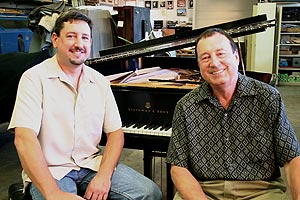
Franco and Giovanni Skilan of Precision Piano Services have devoted their lifetimes to restoring the finest pianos in the world, especially Vintage Steinway and Sons Pianos, with an attention to detail and skill unrivaled in this field. They use their experience to give discerning clients the finest looking and sounding pianos to enjoy for decades to come. We invite you to call and make an appointment to see, play, and hear their work first hand, and to experience a higher level of piano restoration.
Learn more about Giovanni...
Learn more about Franco...
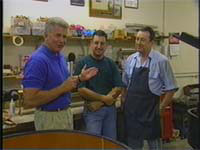
See our PBS interview with California Gold's Huell Howser about our family owned piano restoration company from Huell's series, The Bench
Back to top of page...
|
|
|